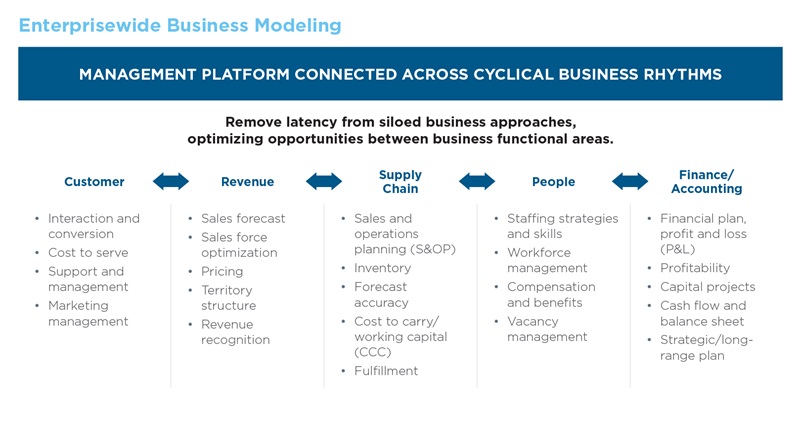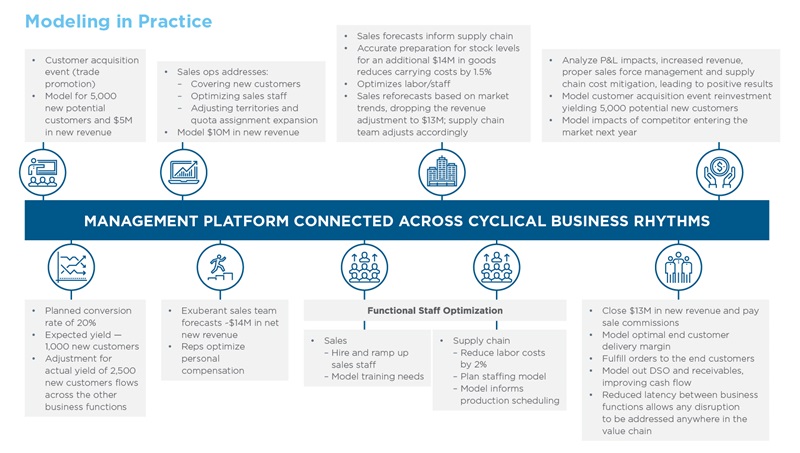The Shift From Planning to Enterprisewide Business Modeling
Enterprise performance management (EPM) systems have become fixtures for monitoring and reporting on financial performance. Alongside enterprise resource planning (ERP) systems, EPM has served as chief financial officers’ (CFOs) gateway for financial planning and analysis and financial close management. But in a rapidly changing business environment, this dated view of EPM is a barrier to growth.
Traditional EPM technologies only provide a partial glimpse into an organization’s performance. Gartner predicts that 70% of financial planning and analysis efforts will expand in scope outside of finance teams over the next few years, making it evident that performance management extends far beyond the CFO’s office.
Going forward, EPM must be unbundled into two distinct constructs — financial planning and analysis, and financial management and close. Both are important to an organization, but each has limits: Planning tends to be a point-in-time exercise occurring on a per-function basis, while financial close and consolidation is mechanical and statutory-mandated.
To keep pace with the velocity of change in today’s market, leaders must intentionally evolve how they think about and approach planning to span across functions and entire businesses. This will be paramount to maintain an accurate read of an organization’s health and opportunities to transform.
Leadership teams’ need for real-time decision making and accelerated operational change will necessitate a move from financial planning to more tightly integrated enterprisewide business modeling.
A Modern Platform to Achieve Faster, More Accurate Operational Decisions
The growing sophistication and falling costs of technology have stoked competition in all industries, with digital-first businesses challenging established organizations for market share across healthcare, financial services, education, retail and more.
Corporate longevity is not guaranteed, compelling leaders to set new strategic visions for their organizations and identify new business models that create future growth. Making these leaps requires a deeper understanding of how a business operates today, including how different functions interact with and impact each other.
Many functional teams still operate in varying degrees of isolation, lacking the technology, processes and culture to provide a comprehensive view of how one group’s plans affect another’s — creating latency that perpetuates unnecessary costs and missed revenue opportunities. This gap cannot be filled by EPM alone; instead, it requires an enterprisewide platform that spans functions, ensuring that changes in any one area are cascaded across the rest at the speed today’s business landscape demands.
With this kind of platform, upward adjustments to an organization’s sales forecast could be instantly reflected in updates to supply chain capacity and staffing needs. The amended forecast may in turn increase the procurement team’s buying power, which could create an opportunity to pass better prices or incentives through to customers.
Manufacturers, for example, often coordinate seasonal trade promotions that inform where products need to be (and when) long in advance. With technology to support enterprisewide business modeling, manufacturers could arrange to ship those orders directly to trade partners. Without that full view, those products may be moved through a warehouse (impacting other inventory and incurring unnecessary labor and transportation costs in the process).
Steps to Expanding Beyond EPM
Encouraging an organization to mature beyond EPM and siloed planning to modeling requires executive leaders to reflect on three fundamental questions:
- What role will our legacy EPM system play going forward? Embracing more pervasive business modeling does not mean leaving EPM behind entirely. EPM systems will still be required for overseeing financial management, close and consolidation activities strongly aligned to ERP systems. The close and consolidation process, while mechanical and necessary for compliance purposes (i.e., external and statutory actuals reporting), does not provide the dynamic reach to model enterprisewide business fluctuations. Only by breaking the legacy EPM construct can leaders pursue comprehensive modeling and set the stage for more effective decision making.
- What does our value chain look like, and where do adjacencies exist? Leaders need to document how internal functions are connected, from customer-facing sales and marketing teams to supply chain, human resources, and finance and accounting departments. This will uncover blind spots, unlocking hidden value where critical information is missing today — and where it needs to be in the future. Mapping the current state can also help pinpoint adjacent processes that could be automated, and areas where predictive technologies could enhance modeling.
- How will we enable the shift to modeling? Technology is just one resource organizations need to mature beyond EPM. Leaders can think about enabling this change in multiple ways:
- Platforms: Leaders should consider implementing a dynamic, enterprisewide platform that acts on information from the existing ERP, customer relationship management (CRM) and human capital management (HCM) systems more effectively. This platform approach positions organizations for the future in two critical ways. First, it strengthens instantaneous information sharing between adjacent functional teams. Second, it lays the groundwork for potential new investments in technologies powered by robotic process automation (RPA), machine learning (ML) and artificial intelligence (AI) to facilitate faster, easier decision making across the business.
- Processes: The same workflows organizations relied on for the last decade won’t suffice going forward, even with modern systems in place. Functional leaders must commit to refining processes not once, but iteratively over time, to accommodate changes in team structure, technology and even the overarching business model.
- People: Successfully embracing modeling depends on employees’ willingness to adapt their thinking and behavior. Employees will have to adjust to not only new systems, but also to working more collaboratively across functional areas. In some cases, team structures may be redesigned to better align with future business and planning needs. Reevaluating compensation and incentives, particularly if they were historically tied to individual per-function performance, can help mitigate complacency with the status quo.
A sound strategic vision is just one step toward long-term transformation. Bringing that vision to life requires organizations to operate in a more fluid, integrated way than ever before. By broadening the scope of EPM to emphasize enterprisewide business modeling over siloed planning, leaders can equip their organizations to be more proactive and resilient for years to come.
KEY TAKEAWAYS
-
Think differently.
Recognize how existing EPM tools and financial planning activities may only provide partial, retroactive insight into corporate performance. -
Plan differently.
Develop a platform technology strategy focused on bridging the information and process gaps that exist between internal functions. -
Act differently.
Proactively reach out to other functional leaders to break down silos, demonstrating the behaviors employees will be expected to emulate.


